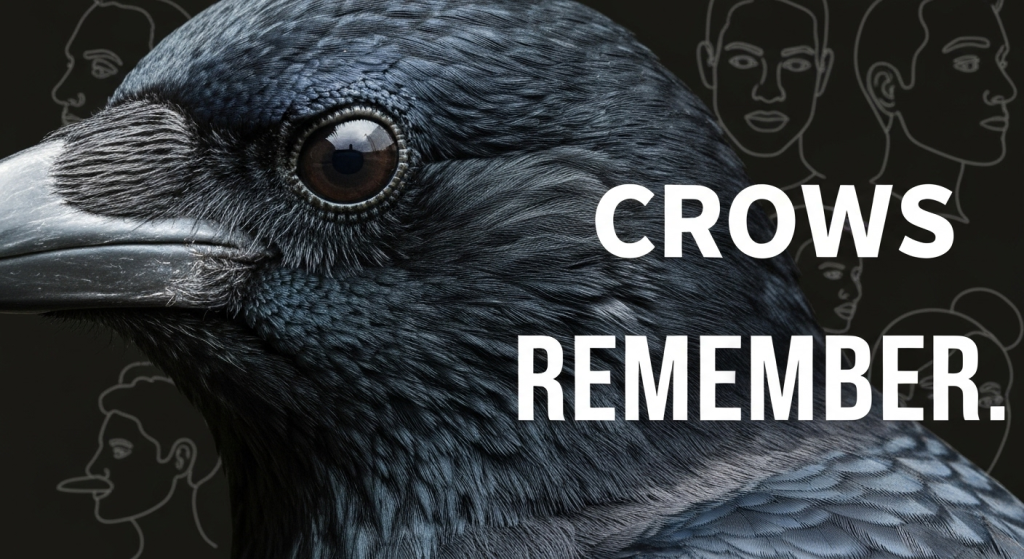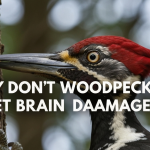Have you ever walked through a park and felt like you were being watched? You look up and see a crow, perched on a branch, its dark eyes seemingly fixed on you. It’s a common feeling, but what if it’s not just your imagination? The truth is, that crow might not only be watching you, but it might also be remembering you from the last time you walked that path. Crows are among the most intelligent animals on the planet, and their ability to recognize and remember individual human faces is a scientifically proven fact that changes how we see the birds in our own backyards.
My name is Mahnoor Farooq, and for years, I’ve been fascinated by the complex world of bird species. My work has involved countless hours in the field, simply observing and documenting the incredible behaviors that unfold around us every day. One of the most common questions people ask me is about the intelligence of corvids—the family of birds that includes crows, ravens, and jays. After more than five years dedicated to this field, I can tell you that their cognitive abilities, especially their memory, are far more advanced than most people realize. This article breaks down the science behind how crows remember us, what it means for them, and how it impacts our daily interactions with these clever urban neighbors.
The Science Behind Crow Intelligence: More Than Just a Bird Brain
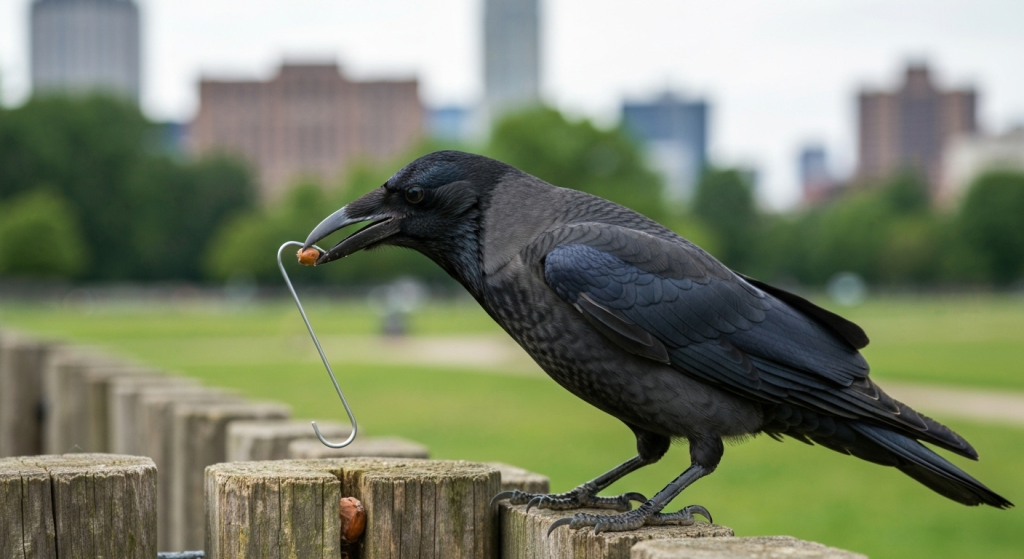
Before we dive into facial recognition, it’s important to understand that crows are exceptionally smart. Their intelligence isn’t a fluke; it’s a product of their unique neurology. The crow family, known as corvids, has a brain-to-body size ratio that is surprisingly large, on par with that of chimpanzees and even humans. This isn’t just about size, though. Their brains are densely packed with neurons, giving them powerful cognitive tools for problem-solving, planning, and social learning.
This intelligence is easy to see in action. During my time observing urban wildlife, I’ve watched crows solve complex problems that would stump other animals. I once saw a crow use a piece of stiff wire to fish a grub out of a crack in a log, bending the wire to create a hook. This wasn’t just instinct; it was tool use, a hallmark of advanced intelligence. This underlying problem-solving ability is the foundation for their more complex social skills, including their uncanny ability to distinguish one human from another. They aren’t just seeing a generic human shape; they are processing the specific features that make your face unique.
The Groundbreaking Study: How We Learned Crows Don’t Forget a Face
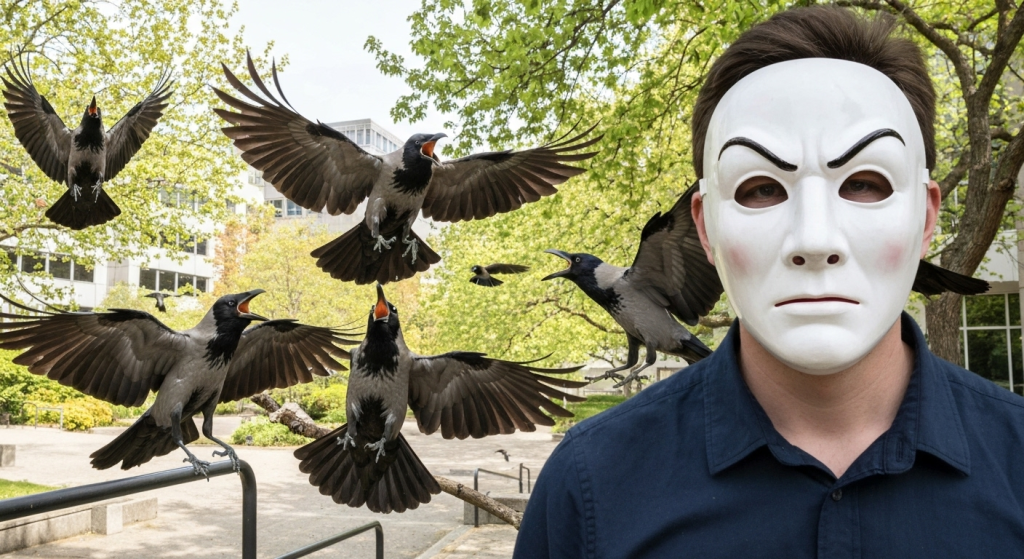
For a long time, the idea that crows could remember specific people was mostly anecdotal. But that all changed with a landmark study that provided concrete proof. This research didn’t just confirm that crows remember faces; it showed how they pass that information on to others in their community.
The University of Washington Experiment
The most famous research on this topic comes from Dr. John Marzluff at the University of Washington. His experiment was clever and straightforward. Researchers wore a specific, highly detailed mask—let’s call it the “dangerous face”—while they captured, banded, and then released crows on campus. This act, while harmless to the birds in the long run, was perceived as a negative and threatening experience.
To create a control group, the researchers also wore a different, “neutral” mask while walking through the same areas without bothering the crows. The results were immediate and striking. Crows began to aggressively “scold” anyone wearing the dangerous mask. This scolding involves loud, harsh calls and sometimes even dive-bombing, behaviors meant to warn other crows and drive a potential threat away. The neutral mask, on the other hand, was completely ignored.
What made this study truly remarkable was its longevity. Years after the initial trapping, people wearing the dangerous mask were still being scolded by the campus crows. Even more amazing, the number of crows participating in the scolding grew over time. Crows that had never been captured, including the offspring of the original birds, had learned to identify the dangerous face as a threat.
| Mask Type | Initial Reaction of Trapped Crows | Reaction After 2 Years | Reaction by Untrapped Crows |
| “Dangerous” Mask | Immediate scolding and alarm calls | Continued, widespread scolding from the flock | Learned to scold the mask by observing others |
| “Neutral” Mask | No reaction; crows went about their business | Consistently ignored | No reaction; treated as a non-threat |
What This Proved About Crow Memory and Social Learning
The University of Washington study proved two critical things. First, crows have incredibly long-term memories when it comes to faces associated with negative experiences. They could remember the dangerous mask for at least five years. Second, and perhaps more importantly, crows transmit this knowledge socially.
This is a huge deal. It means that a crow doesn’t need to have a bad experience with a person firsthand to learn that they are a threat. They can learn it simply by watching their parents or other flock members react negatively. This social learning is a sophisticated survival strategy. It allows an entire generation of crows to become aware of a potential danger without ever having to face it themselves. In my own observations of local crow families, I’ve noticed this pattern. If one crow has a scare from a particular dog or person, the entire flock becomes wary of them within days. It’s a powerful and efficient information network.
Inside the Crow’s Mind: The Neural Mechanics of Facial Recognition
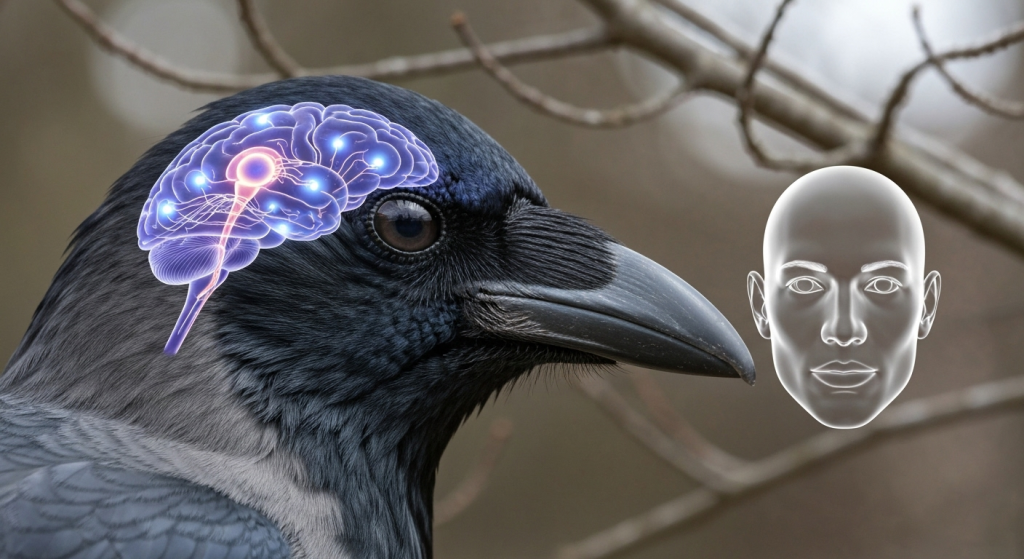
So, how does a crow’s brain actually accomplish this? While a bird’s brain is structured differently from a mammal’s, it contains regions that perform similar complex functions. Crows use a highly developed part of their brain to process and store information about faces, linking visual data to emotional experiences.
Researchers using brain imaging techniques, like fMRI scans on crows, have found that when a crow sees a face associated with a threat, specific regions of its brain light up. These areas are involved in associative learning and emotional response, similar to the amygdala in humans. The crow’s brain isn’t just taking a snapshot; it’s attaching a strong emotional tag to that visual memory. It’s the difference between seeing a face and seeing a threat.
Let’s break down what’s happening in their brains.
- Pattern Recognition: The crow’s brain is excellent at identifying and remembering specific patterns, such as the distance between your eyes, the shape of your nose, and other unique facial features.
- Emotional Association: It then links this facial pattern to an emotional experience. If you offer them food, the association is positive. If you disturb their nest, the association is strongly negative.
- Long-Term Memory Storage: This face-plus-emotion package is then stored in their long-term memory, ready to be accessed the next time they see you.
- Social Signaling: When a known “negative” face is spotted, the brain triggers a response—the alarm calls and scolding—to alert the entire flock.
Real-World Encounters: Documented Cases of Crow Memory in Action
The science is fascinating, but the real-world stories are what truly bring a crow’s intelligence to life. There are countless documented cases from around the world that support the lab findings.
One of the most heartwarming examples is the story of Gabi Mann, a young girl in Seattle who started feeding the crows in her garden. In return, the crows began bringing her gifts—small, shiny objects like buttons, earrings, and polished rocks. They not only recognized her as a friend but actively sought to reciprocate her kindness, leaving these treasures in the birdbath for her to find.
On the flip side, many people have stories of being targeted by crows after a negative interaction. Someone who tried to remove a nest from their yard might find themselves being scolded and dive-bombed by that crow family for years to come. This isn’t random aggression; it’s a targeted response based on a specific memory. Over my five years of documenting local bird behavior, I’ve always made a point to be a predictable and non-threatening presence. The crows in my local park now recognize me. They forage calmly when I am near, a stark contrast to how they scatter when an unfamiliar person approaches too quickly. This quiet trust was built over hundreds of hours of mutual respect.
Living with Our Clever Neighbors: How Crow Recognition Affects Us
Understanding that crows remember us has real-world implications. It means our actions toward them matter. Being recognized by your local crow flock can be a positive or negative experience, depending entirely on the history you have with them.
The Pros and Cons of Being Remembered
The way a crow flock perceives you can lead to very different outcomes. Being seen as a friend can be a rewarding experience, while being identified as an enemy can become a long-term nuisance.
| The Two Sides of a Crow’s Memory | |
| Being a “Friend” (The Pros) | Being an “Enemy” (The Cons) |
| Crows will be calm in your presence. | Crows will scold you with loud, harsh calls. |
| They may follow you out of curiosity. | They may dive-bomb you, especially near nests. |
| You are less likely to be mobbed during nesting season. | They will teach other crows, including their young, that you are a threat. |
| In rare cases, they may leave you small “gifts.” | This negative reputation can last for years. |
Building a Positive Relationship with Local Crows
So, how can you stay on a crow’s good side? You don’t have to actively feed them to build a positive reputation. The key is to be a neutral or positive presence.
- Be Predictable: Crows are smart and notice patterns. If they see you walking the same route every day without bothering them, they will learn you are not a threat.
- Give Them Space: This is the most important rule, especially during the spring and early summer when they are nesting. Fledglings (young birds that have just left the nest) are often on the ground, and their parents are extremely protective. Getting too close is the fastest way to be labeled a threat.
- Never Act Aggressively: Don’t yell at them or throw things in their direction. They will remember it, and so will their friends.
By simply being a respectful neighbor, you can coexist peacefully with these intelligent birds and appreciate their presence in our shared environment.
Frequently Asked Questions (FAQs)
1. How long can a crow actually remember a human face?
Scientific studies have confirmed that crows can remember a specific human face for at least five years. However, given their long lifespans (15-20 years in the wild), many ornithologists believe this memory could last a lifetime.
2. Do crows recognize other things besides faces, like cars or clothing?
Yes. Crows are incredibly observant and are masters of associative learning. They can and do associate specific threats with the clothes a person was wearing, the car they were driving, or even a particular time of day.
3. Is it safe to be around crows that are scolding me?
Generally, yes. Scolding is a warning and a way to communicate a threat to the rest of the flock. They are telling you to back away. Actual physical contact is very rare and typically only happens if you are extremely close to their nest or a vulnerable fledgling on the ground.
4. Can I make friends with a crow?
You can certainly build a relationship of trust. This is best done by being a consistent, non-threatening presence. While leaving out food can create a bond, it’s important to check local bylaws, as feeding wildlife is discouraged in some areas. A relationship built on mutual respect is often the most rewarding.
Conclusion
The next time a crow seems to be watching you, take a moment to consider what’s happening behind those intelligent eyes. This isn’t just a simple bird; it’s a highly evolved creature with a complex social life, a powerful memory, and the ability to distinguish you from every other person it sees. The research from the University of Washington and countless real-world observations have pulled back the curtain on their cognitive world, revealing that our actions have lasting consequences.
Living in cities means sharing our space with wildlife, and crows are some of our most adaptable and intelligent neighbors. They remember the faces of those who are kind and, even more so, the faces of those who pose a threat. Understanding this simple fact is the first step toward fostering a more respectful and fascinating coexistence with the clever, black-feathered observers who watch over our world.
